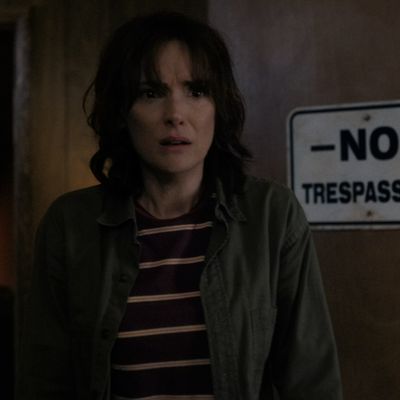
Casting Winona Ryder in Stranger Things seems like an appropriately ‘80s thing to do for a series so immersed in the era. Heathers didn’t come out until 1988, four years after the show is set, but Ryder’s performance hit Gen-Xers like your humble recapper hard. If you grew up on early-to-mid-’80s popular entertainment, but your taste started to shift more toward, say, the Clash’s “Should I Stay or Should I Go” and Modern English’s “I Melt With You” (to use episode-appropriate examples), there was something resonant about Ryder’s image. As Reality Bites made it almost insultingly clear six years later, she was the avatar of alterna-teen cool. (I’m reminded of a favorite Onion story: Nation Falls In Love With Girl From Record Store.)
The Duffer brothers are aware of the Ryder iconography, but so far, Stranger Things has been smart about tweaking it. As Joyce, Ryder doesn’t draw on her past for a moment — and this on a show that does almost nothing but reference the past. Instead, the role is giving us Ryder as we’ve never quite seen her before, casting an actress known for cool, dark, urbane wit as a chain-smoking, working-class single mother from the Midwest who’s fighting like hell to find her son. Though she’s shown flashes of the person she was before Will disappeared, particularly in her shorthand with Hopper, Joyce has spend these first two episodes in a constant state of bleary-eyed determination, as Ryder plays this difficult role with raw, authentic emotion. She doesn’t have the “cool-girl” distance of Heathers and Beetlejuice anymore. She’s come to fight.
In perhaps the most powerful sequence in “The Weirdo on Maple Street,” Stranger Things brings yet another ‘80s touchstone into the mix, suggesting that Will has become a ghost in the machine like Carol Anne in Poltergeist. (We know from last episode’s flashback that Joyce took Will to see Poltergeist, so it must feel like déjà vu for both of them.) After being contacted by a strange voice she recognized as her son’s the night before — an incident that fried her phone — Joyce buys a new phone and sits perched in a recliner with the receiver in her lap, waiting for another call. When she gets it, the house comes alive with disturbances: the lights flicker, the boombox in Will’s room starts playing the Clash, the wall distends like the television in David Cronenberg’s Videodrome. It feels like a menace and Will’s attempt to communicate with his mother. When Joyce flees, the house lights up again with the same distress signals — and, in this moment of peril, she decides to go back inside. It’s a mother’s instinct, the supernatural equivalent to dashing into a burning building.
Picking up after last episode’s cliffhanger, “The Weirdo on Maple Street” also reveals more about the mysterious runaway girl whom Dr. Brenner and his Hazmat-suited goons are trying to capture. She refuses to talk for awhile and doesn’t have any idea how to act around other kids. (Dustin’s “Oh my God! Oh my God! Oh my God!” reaction to her nearly taking off her clothes in front of them is priceless. He’s not ready to accelerate to post-pubescence quite yet.) Mike names her Elle, short for the “11” tattoo on her wrist, and she seems to have some knowledge of Will, but lacks the ability to articulate what that might be. She does, however, have Yoda-like superpowers, which dazzles Mike and his buddies, and she quite literally learns the meaning of friendship, which is a foreign concept to a girl living in isolation and trauma.
Stranger Things is taking its time to answer questions about what Dr. Brenner and the institute have to do with Elle, Will, and the creature that’s snapping up the citizens of Hawkins, including Nancy’s friend Barb, who’s the latest victim. We don’t yet know what the institute did to trigger these forces — or perhaps what they failed to do in an earnest effort to contain them — but these mysteries are especially vexing because only the viewer has all the information at hand. Mike and friends know Elle’s location and her power; Hopper knows about the “suicide” at Benny’s Burgers, but is led to believe the kid in Benny’s kitchen was possibly Will; Joyce is having trouble convincing Hopper that she heard her son on her phone. These pieces of evidence might add up to a theory or a strong line of inquiry for Hopper, but they’re all discombobulated, like the faint flickers of light in Joyce’s house.
Along with various independent parties who conduct some sleuthing — namely, Hooper, Joyce, Mike and friends, and Dr. Brenner — Joyce’s son Jonathan has also launched his own investigation. First he visits his deadbeat father Lonnie, who’s every bit the selfish cretin that one might have expected, still slipping in digs at Joyce in this time of distress. Then he takes his camera into the woods and starts taking pictures, hoping dimly that random shots of the abduction scene will somehow tell the story that eluded authorities. But things take a turn when he hears a scream and follows it to the backyard pool where Steve is hosting a get-together while his parents are away.
Looking a bit like Jimmy Stewart in Rear Window — or, if we want to get our era-specific references straight, Craig Wasson’s telescope peeper in Brian De Palma’s 1984 thriller Body Double or Kyle MacLachlan in David Lynch’s 1986 noir Blue Velvet — Jonathan forgets his mission to take shots of Nancy, who’s in the midst of shedding her good-girl image with the wrong guy. His creepy voyeurism detours sharply from his heroic motives for going in the woods, and it’s not clear whether his camera catches the moment when Barb gets snatched off the diving board. Whatever the case, Jonathan isn’t the pure-hearted young man we assumed him to be. He’s got mysteries, too.
Demogorgons:
- The awareness of Joyce’s economic stresses continues to add depth to the show. She needs to run off two or three hundred copies of Will’s missing-person poster, but she still has to calculate what it’ll set her back. Later, she has to beg her employer for a two-week advance on her salary to buy a $22 replacement phone. When a second call fries that phone, she’s upset not only by the supernatural forces invading her home, but the cost of getting a third phone.
- I’ll talk more about Hopper in later recaps, but his previous relationship with Joyce, combined with investigative instincts honed from his time as a big-city cop, make him a more layered character than the Schlitz-swilling yokel his introduction suggested. For one, Benny’s “suicide” raises a red flag. In the city, citizens were strangers to him; in small-town Indiana, he knows the people well enough to question the motives assigned to them.
- Jonathan’s flashback with Will, when he introduces him to the Clash, is a testament to the power popular art has to take us back to a specific time and place, like Marcel Proust’s madeleine. That scene is, in a nutshell, what Stranger Things itself is all about: a journey back to a cultural period that the Duffers view affectionately.
- The Bangles cover of “Hazy Shade of Winter” was originally recorded for Less Than Zero, an excellent Rick Rubin–produced soundtrack for a film that emphatically did not deserve it. The film came out in 1987, but there’s no use quibbling over non-diegetic music choices, especially when they carry the episode out this thrillingly.


